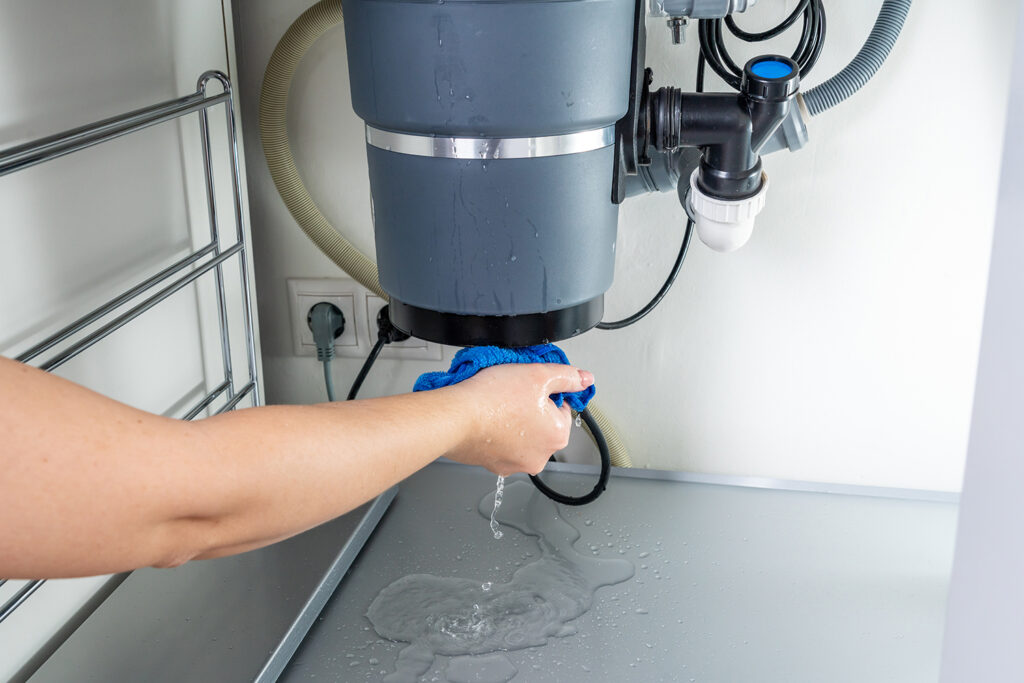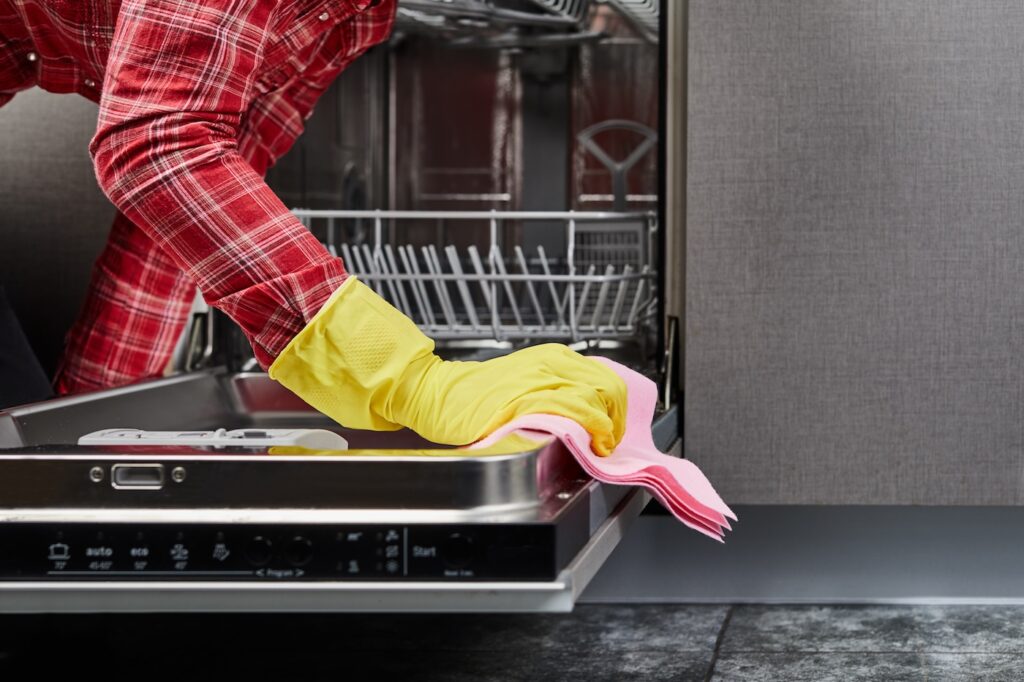Garbage Disposal Leaking? Here’s Why and How to Solve It
Have you discovered a mysterious pool of water beneath your kitchen sink, or perhaps an unpleasant smell from the cabinet below? These could be telltale signs that your garbage disposal is leaking. In this case, it’s better to address the problem sooner rather than later. A leaky garbage disposal can result in mold, electrical hazards, or escalating damage including damaged kitchen cabinets and flooring.
Fixing this issue might seem daunting, especially if you’re concerned about the cost, but the good news is tackling a leaky garbage disposal is a DIY project that requires minimal time, money, and effort. Through this guide you can identify why water is leaking and the steps of how to fix a leaking garbage disposal. Let’s get your kitchen back on track!
3 Reasons Why You Have Water Leaking From Garbage Disposals
If water is leaking from your garbage disposal, chances are it’s due to one of three common reasons. Let’s explore each scenario:
1. Internal Damage
If the leakage comes from the base of the garbage disposal unit, internal damage to seals is likely the culprit. In this case (and worst-case scenario) it is recommended to upgrade to a new system. Internal damage is a serious issue and often requires a new system. If you notice the leak coming from the kitchen handle, this is likely a different issue.
2. Worn or Damaged Seals
Leaks from the top rim, where the rubber seal connects to the disposal flange, or from the upper region of the garbage disposal, indicate worn or damaged seals. Addressing this involves replacing the seal with plumber’s putty or replacing the gasket. More on both of these later.
3. Loose or Improperly Installed Connections
Finally, the leak could be due to loose drain lines, especially if the disposal is leaking from the side. We’ll walk you through how to tighten a garbage disposal by tightening the clamps below.
Project Overview
You can expect this project to take anywhere from 30 minutes to an hour with total costs coming in under $10. Additionally, this job requires an intermediate skill level.
Supplies Needed
To get started you’ll need the following tools and materials on hand:
Tools
- Wrench
- Pliers
- Screwdriver
Materials
- New gasket
- Plumber’s putty
How to Fix a Leaking Garbage Disposal
Now you’re ready to tackle the job, let’s dive into the step-by-step process for how to fix a leaking garbage disposal.
Garbage Disposal Leaking From Top
If you notice the garbage disposal leaking from the top, first disconnect the drain and unplug the garbage disposal outlet. If you have a dishwasher, also remove the dishwasher drain. Using a wrench, twist the mounting nuts located at the top of the unit to remove the garbage disposal. If the issue lies with the flange, loosen its bolts and move the clip to pull the flange from the top of the sink. Next create a rope of plumber’s putty and generously apply it to the rim of the flange. Re-insert the flange into the sink until snug. Finally re-install the mounting assembly, mounting ring, and re-attach the garbage disposal, drain pipe, and dishwasher hose. Test for any leaks.
If your garbage disposal requires a new gasket rather than resealing the flange, peel off the old gasket from the removed garbage disposal unit and place the new gasket in the same location. Proceed with reattaching the parts and testing the disposal for leaks.
Garbage Disposal Leaking From the Side
Loose drain lines can lead to leaks. To resolve a garbage disposal that leaks from the side, use a screwdriver to tighten the metal clamp that connects the drain lines from the disposal to the dishwasher. You can also tighten the screws on the main drain line as well. It’s important to secure all connections to prevent any future leaks.
Garbage Disposal Leaking From Bottom
Seals located inside the garbage disposal wear out over time. If you notice your garbage disposal leaking from the bottom, especially from the reset button, it’s time to install a new garbage disposal. You can expect a new garbage disposal to last anywhere from eight to 15 years.
How to Prevent Future Leaks
After putting in the hard work to fix your leaky garbage disposal, take measures to prevent future damage. This includes grinding only soft foods, avoiding hard items such as bones, apple cores, potato skins, and eggshells. Additionally, there are ways to clean your garbage disposal to get rid of any unwanted smells. When using the disposal, running cold water–instead of hot–helps the grinding process. And finally, be sure to run cold water both before and after disposing of food, including fats. By following these tips, you can protect your disposal and maximize its efficiency.
Mistakes to Avoid
On top of proper maintenance, there are other issues that can cause garbage disposal problems. First, don’t overload the unit, and second, be weary of chemical drain cleaners. Not only are they a potential environmental hazard if they enter water systems, but they can corrode pipes over time. In the case of a clog, try unclogging your sink drain by pouring a half cup of baking soda and following up with half a cup of vinegar. Cover the drain and let sit for 30 minutes, then pour hot or boiling water down the drain to clean any debris.
Additionally, sometimes you’ll hear strange noises coming from your garbage disposal. In this case, you’ll want to turn off the power before inspecting for foreign objects. Look into the disposal with a flashlight to check for anything causing the noise. If you don’t see anything, try using the reset button at the bottom of the unit. If the noise persists, enlist help or consult the manufacturer’s manual.
Outside of strange noises, your garbage disposal can become jammed or have slow grinding. To resolve this, pour a tray of ice cubes into the disposal, followed by a cup of rock salt. Then turn on the disposal and let the ice and salt clean the blades and break up any residue. Follow this up with a cold water rinse.
Environmentally Friendly Disposal Practices
Being mindful of what goes into the disposal can extend its lifespan. To be environmentally conscious, a great way to dispose of food is to compost food scraps. Some communities even offer a food waste recycling program that collects food scraps for industrial composting. Another pro tip is to freeze vegetable scraps, such as carrot peels, onion ends, and herb stems to make a homemade vegetable broth once you have enough. Finally, educate everyone in your house about disposal practices and encourage them to participate in reducing food waste.
FAQs
Do I need a plumber to fix a leaking garbage disposal?
Depending on the severity and cause of the leak, you may need a plumber. If you’re comfortable with DIY tasks and the issue is minor, you might be able to address it yourself. Read this article to determine the best route for your issue.
How can I identify the source of the leak?
Leaks can occur for various reasons, such as loose connections, damaged pipes, a faulty seal, or a cracked disposal unit. To identify the source, visually inspect the disposal, sink connections, and pipes. Look for water accumulation or dampness. Running water and observing where the leak occurs can also help pinpoint the source.
Hire a Tasker and Solve the Problem!
If you’re uncomfortable with the task or feel your skill set may not be a match, book a Tasker for peace of mind. Taskers have the experience to fix your leaky garbage disposal, and help with all of your plumbing needs, ensuring a seamless return to a functioning kitchen without the hassle of tools or troubleshooting.














